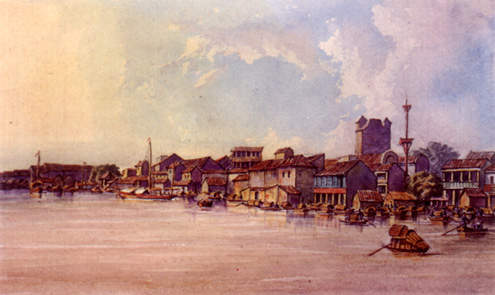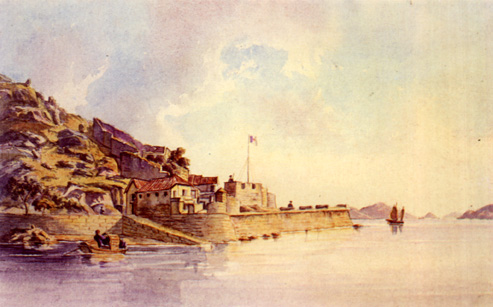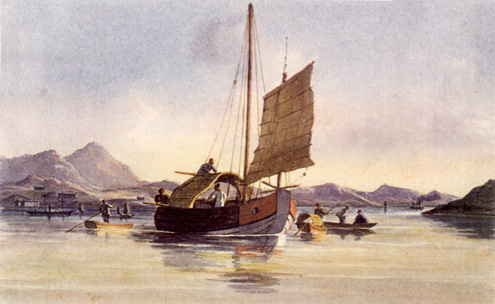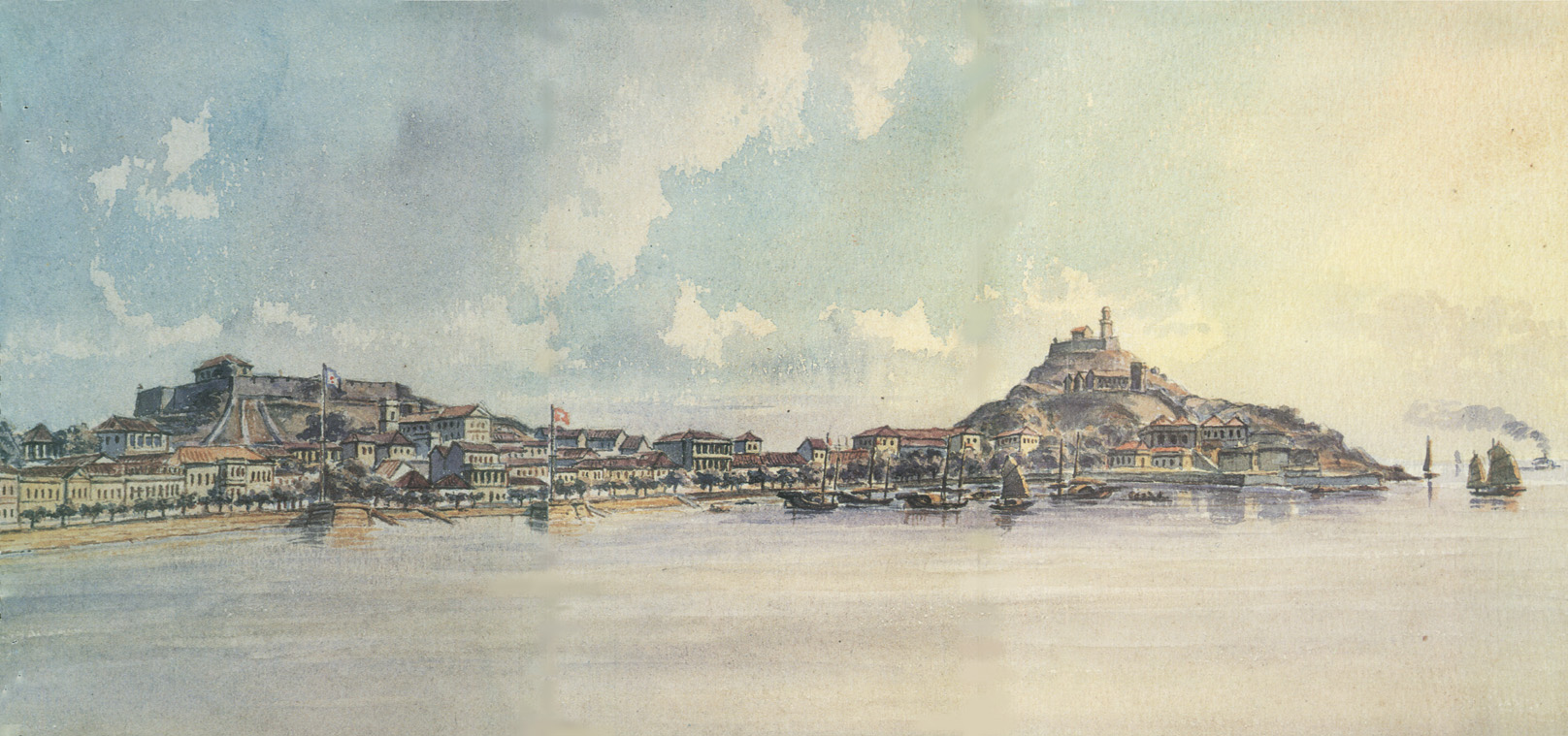 Honan, Canton (watercolour on paper, 13.5 x 22.3cm, signed, c. 1875-80; Martin Gregory Gallery)
Honan, Canton (watercolour on paper, 13.5 x 22.3cm, signed, c. 1875-80; Martin Gregory Gallery)
As an artist who spent all his life (so far as is known) in Macau and Hong Kong, with occasional sketching expeditions along the South China coast, Marciano Baptista must have felt himself isolated - cut off from the great artistic traditions of mainland China on the one hand, and of far-distant Europe on the other.
Yet the work of Baptista does fall quite clearly within the latter tradition. Since the sixteenth century, European artists had been producing 'topographical drawings' - that is, drawings of particular places, to which watercolour might be added. Sometimes precise drawings of this kind were required for military purposes, or for land surveys; alternatively the skills involved in making such drawings were taught to young ladies and gentlemen as part of a 'polite education'.
In the seventeenth century the Bohemian draughtsman and engraver Wenceslaus Hollar came to London, where he made numerous drawings of English buildings; English-born artists followed Hollar's lead, and by the beginning of the nineteenth century the practice of topographical watercolour had become something of a British speciality. In the hands of such practitioners as Paul Sandby, Michael 'Angelo' Rooker and the young J. M. W. Turner, topographical watercolour had been developed into a subtle art. In which colour, no less than outline, now played a significant role.
A critical catchword among theorists at this time was 'picturesque'. Artists both amateur and professional would tour the countryside in search of 'picturesque' subjects to draw or admire. Although there was controversy over the exact meaning of the word, many agreed that a 'picturesque' composition could and should represent natural and man-made objects with a considerable degree of accuracy and detail. Whenever possible, a 'picturesque' view should exhibit variety and irregularity; the skyline should be broken or asymmetrical, and if a shoreline or a row of buildings was depicted, it should be from an angle, rather than from directly in front. There should be some foreground detail. In the form of figures or animals, or perhaps plants or boulders, or boats. And in the sky there should be some cloud formation, rather than a uniform blue or grey.
 Fortress of São Tiago da Barra - entrance to the Inner Harbour, (watercolour on paper, signed, c. 1875-80; Martin Gregory Gallery)
Fortress of São Tiago da Barra - entrance to the Inner Harbour, (watercolour on paper, signed, c. 1875-80; Martin Gregory Gallery)
It was this aesthetic Ideal which prevailed during the formative years of George Chinnery in England and Ireland. Chinnery left England for India in 1802, when the vogue for 'picturesque' topography was at its height, and In 1825 he moved on to the China coast.
He never returned to his native land. If he had done so, he would have found considerable changes in the methods and Ideals of English watercolourists; he would have observed a tendency towards more elaborate compositions, and an increasing fondness for opaque colour - gouache, or body colour - which was little used by Chinnery's early contemporaries. Far removed from these changing fashions, however, Chinnery continued to employ the pure watercolour style in which he had been raised; and this was adopted in large measure by his follower, Marciano Baptista.
It could be said that Baptista's technique was partly determined by Chinnery's long visit to India; for if Chinnery had come to Macau in 1825 directly from England, he would surely have brought with him a rather different conception of watercolour painting, which would in turn have beer reflected in the work of Marciano Baptista.

Chinese junk in Hong Kong harbour (watercolour on paper, signed, c. 1875-60)
Baptista's watercolours are consistent with many of the tenets of the 'picturesque'. Chinese figures and sampans provide much of the foreground activity, sometimes in contrast with a smoke-belching steamer at a distance; Façades of buildings are viewed from an angle and interspersed with vegetation; and the skies contain clouds whose bright, sunlit edges are indicated in the classic watercolourist's manner, by allowing the plain white of the paper to appear, rather than adding highlights of white body colour. For certain special effects, such as the light of the moon on the sea, Baptista uses the method of 'scratching out' the colour with a sharp point, so that the effect of brightness is again provided by the underlying paper.
This is not to say that Baptista was consciously following a set of precepts which had first been formulated nearly a century before, and nearly ten thousand miles away. Nor can it be claimed that his work is consistently skilful or successful. He lacked the great advantage, which Chinnery had enjoyed, of learning to draw and paint in a milieu of regular exhibitions, artists' societies and public enthusiasm. Nevertheless Baptista can be regarded as a worthy follower in a strong tradition of topographical watercolour. If its seeds were planted in Europe many generations before, then the watercolours of Girtin and Turner, Cotman and Chinnery represent it’s blossoming, and those of Marciano Baptista an exotic late flowering.

RC Poster
View of Praia Grande Marciano Baptista, c.1875-80
(watercolour on paper, signed; Martin Gregory Gallery)
* Formerly Keeper of Fine Arts at the Royal Pavilion, Art Gallery and Museums, Brighton, Patrick Conner is now an associate of the Martyn Gregory Gallery in London. Among his publications are the books Savage Ruskin (1979). Oriental Architecture In the West (1979) and Michael Angelo Rooker (1746- 1801) (1981). The Inspiration of Egypt (1983) and The China Trade 1600-1869 (1966). He is currently preparing a book on George Chinnery.
start p. 168
end p.